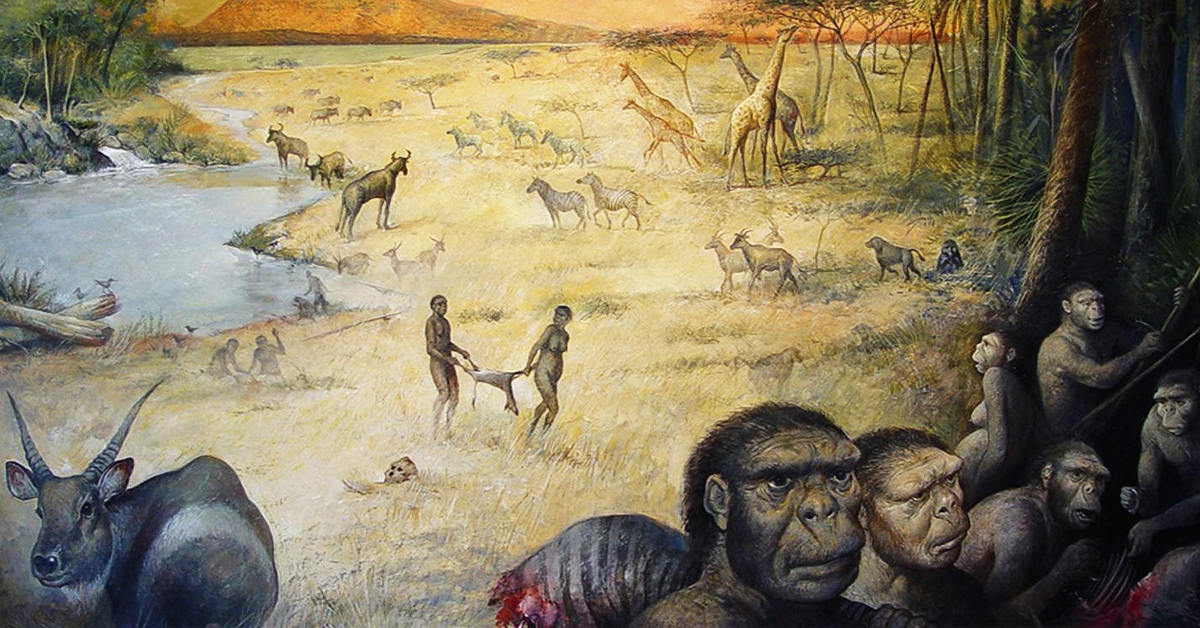


An online article from RUTGERS UNIVERSITY/AAAS - Early human habitat, recreated for first time, shows life was no picnic - reports that pioneering Rutgers scientist helps reconstruct an ancient East African landscape where human ancestors lived 1.8 million years ago.
Scientists have pieced together an early human habitat 1.8 million years ago.
Our human ancestors, who looked like a cross between apes and modern humans, had access to food, water and shady shelter at a site in Olduvai Gorge, Tanzania. They even had lots of stone tools with sharp edges, said Gail M. Ashley, a professor in the Rutgers Department of Earth and Planetary Sciences in the School of Arts and Sciences.
https://t.co/6eoCptJasU East African landscape where human #ancestors lived 1.8 million years ago #hominins pic.twitter.com/jPIsASv22y
— Bradshaw Foundation (@BradshawFND) March 10, 2016
She claims that it was a very stressful life because these human ancestors were in continual competition with carnivores for their food.
During years of work, Ashley and other researchers carefully reconstructed an early human landscape on a fine scale, using plant and other evidence collected at the sprawling site. Their pioneering work was published recently in the Proceedings of the National Academy of Sciences.
The landscape reconstruction will help paleoanthropologists develop ideas and models on what early humans were like, how they lived, how they got their food (especially protein), what they ate and drank and their behaviour.
Famous paleoanthropologist Mary Leakey discovered the site in 1959 and uncovered thousands of animal bones and stone tools. Through exhaustive excavations in the last decade, Ashley, other scientists and students collected numerous soil samples and studied them via carbon isotope analysis.
The landscape had a freshwater spring, wetlands and woodland as well as grasslands.
Ashley's team were able to map out what the plants were on the landscape with respect to where the humans and their stone tools were found. Mapping was done by analyzing the soils in one geological bed, and in that bed there were bones of two different hominin species.
The two species of hominins, or early humans, are Paranthropus boisei - robust and pretty small-brained - and Homo habilis, a lighter-boned species. Homo habilis had a bigger brain and was more in sync with our human evolutionary tree, according to Ashley. Both species were about 4.5 to 5.5 feet tall, and their lifespan was likely about 30 to 40 years.
Through their research, the scientists learned that the shady woodland had palm and acacia trees. They don't think the hominins camped there. But based on the high concentration of bones, the primates probably obtained carcasses elsewhere and ate the meat in the woods for safety. A layer of volcanic ash - a volcano is about 10 miles from the site - covered the site's surface, nicely preserving the bones and organic matter.

On the site, scientists found thousands of bones from animals such as giraffes, elephants and wildebeests. The hominins may have killed the animals for their meat or scavenged leftover meat. Competing carnivores included lions, leopards and hyenas, which also posed a threat to hominin safety.
The subject of eating meat is an important question defining current research on hominins. The increase in the size of the brain is probably tied to more protein. The hominins' food also may have included wetland ferns for protein and crustaceans, snails and slugs.
Scientists think the hominins likely used the site for a long time, perhaps tens or hundreds of years.
The study was conducted by Ashley; Clayton R. Magill of the Geological Institute in Zurich, Switzerland; Manuel Dominguez-Rodrigo of Complutense University in Madrid, Spain; and Katherine H. Freeman of Pennsylvania State University.
Read more about the human evolutionary tree in ORIGINS:
http://www.bradshawfoundation.com/origins/index.php
by Bradshaw Foundation
Tuesday 21 March 2023
by Bradshaw Foundation
Tuesday 07 February 2023
by Bradshaw Foundation
Thursday 19 May 2022
by Bradshaw Foundation
Tuesday 19 October 2021
by Bradshaw Foundation
Friday 25 June 2021
by Bradshaw Foundation
Monday 09 November 2020
by Bradshaw Foundation
Tuesday 03 November 2020
by Bradshaw Foundation
Wednesday 28 October 2020
by Bradshaw Foundation
Tuesday 23 June 2020
by Bradshaw Foundation
Thursday 04 June 2020
by Bradshaw Foundation
Thursday 14 May 2020
by Bradshaw Foundation
Tuesday 12 May 2020
by Bradshaw Foundation
Wednesday 19 February 2020
by Bradshaw Foundation
Tuesday 21 January 2020
by Bradshaw Foundation
Monday 20 January 2020
by Bradshaw Foundation
Thursday 28 November 2019
by Bradshaw Foundation
Tuesday 21 March 2023
by Bradshaw Foundation
Tuesday 07 February 2023
by Bradshaw Foundation
Thursday 19 May 2022
by Bradshaw Foundation
Tuesday 19 October 2021
by Bradshaw Foundation
Friday 25 June 2021
by Bradshaw Foundation
Monday 09 November 2020
by Bradshaw Foundation
Tuesday 03 November 2020
by Bradshaw Foundation
Wednesday 28 October 2020
by Bradshaw Foundation
Tuesday 23 June 2020
by Bradshaw Foundation
Thursday 04 June 2020
by Bradshaw Foundation
Thursday 14 May 2020
by Bradshaw Foundation
Tuesday 12 May 2020
by Bradshaw Foundation
Wednesday 19 February 2020
by Bradshaw Foundation
Tuesday 21 January 2020
by Bradshaw Foundation
Monday 20 January 2020
by Bradshaw Foundation
Thursday 28 November 2019
Friend of the Foundation











